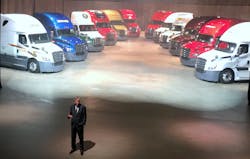COLORADO SPRINGS, CO. Trucking has changed a lot in the past seven years. When Martin Daum was named president and CEO of Daimler Trucks North America in 2009, the U.S. economy was quietly descending into what’s now recognized as “the Great Recession,” and trucking was sliding from one of its boom cycles into an extended downturn. But the resulting fleet bankruptcies and consolidations haven’t brought the biggest changes to trucking over the last seven years, according to Daum. The biggest changes he’s seen haven’t been driven by the economy, but rather by the flood of new industry regulations.
“Regulations make it really tough” to run a fleet these days, Daum told Fleet Owner. Whether it’s hours-of-service changes, safety recordkeeping requirements, or other newly imposed Federal regulation, “these are huge burdens for big or small fleets,” he said.
The constant pressure fleets are under to find qualified drivers only adds to that burden, Daum said, as does the ever-present possibility of a liability suit that could close down almost any fleet. “And that burden keeps getting bigger with absolutely no easing on the horizon.” he said.
One “positive surprise” over the last seven years has been fleet response to much lower fuel prices. “I expected their fuel efficiency technology [investment] to rise and fall with prices, but it hasn’t,” according to Daum. “They continue to make the investments because they expect [fuel prices] will go up again.”
As a truck manufacturer, the biggest change over his initial seven years at DTNA has been the emergence of connectivity as a main driver in both truck technology and fleet operations. “For me, real-time information on how a truck is performing combined with smart analytics is necessary to deliver real value,” Daum said. “Our customers need information to run their businesses smarter. They can’t wait until the truck comes back in to get it, especially if it’s safety related. They want that information immediately.”
When the company introduced its Virtual Technician remote diagnostics system four years ago, “I didn’t really see just how far it could go,” Daum recalls. “But our partner Zonar saw the possibilities, and being creative helped us, our dealers and our customers learn.”
Looking forward, Daum believes “deep integration” of all truck systems will be absolutely necessary to achieve the highest levels of fuel efficiency, productivity and safety. “We’ll always offer choices [in vehicle specifications] because we have a diverse population of customers and our product line has to reflect that,” he says. But the gains in fuel economy promised for the next generation Cascadia and its highly advanced safety systems wouldn’t be possible without that kind of integration. “It’s inevitable,” concludes Daum.
About the Author
Jim Mele
Jim Mele is a former longtime editor-in-chief of FleetOwner. He joined the magazine in 1986 and served as chief editor from 1999 to 2017.
